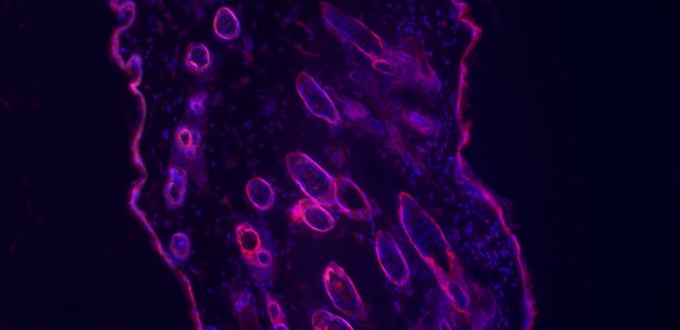You are here
Combating Allergies and Supporting Students with LabArchives

Research requires more than collecting, analyzing, and presenting data. It’s easy to get bogged down in the details of managing a lab, especially when your staff is small and you’re mentoring undergraduate researchers. Tina Sumpter, research assistant professor of Dermatology, uses Electronic Research Notebooks (LabArchives) to make it work—even during a pandemic.
Research project management at the University of Pittsburgh
 Tina Sumpter, PhD, research assistant professor in the Department of Dermatology in the School of Medicine at the University of Pittsburgh, manages a research lab with one technician and a lot of undergraduate researchers. In addition to actually getting research done, she must coordinate many different people, all working on the same project. It’s not an easy task, but she makes it work with LabArchives.
Tina Sumpter, PhD, research assistant professor in the Department of Dermatology in the School of Medicine at the University of Pittsburgh, manages a research lab with one technician and a lot of undergraduate researchers. In addition to actually getting research done, she must coordinate many different people, all working on the same project. It’s not an easy task, but she makes it work with LabArchives.
Sumpter’s lab researches allergies and skin. As an immunologist and cell biologist, she looks at how cells play a role in allergies—and is in the process of developing new inhibitors for dermatitis. What does that really mean? Think of it this way: Public speaking makes Subject A nervous and causes him/her to break out in hives. This is a classic example of the nervous system and immune system interacting in a way that leaves the human subject in a less than ideal state. This ‘cross-talk’ between systems causes the rash to present itself. Luckily, inhibitors can prevent these negative signals and their itchy aftermath.
Sumpter and her lab are developing inhibitors for this exact situation. Conducting high-level research like this with undergraduate contributors, however, has unique challenges. Organization is key. Pitt Information Technology offers LabArchives and other digital tools to help researchers and instructors like Sumpter keep it all afloat.
Organization
When Sumpter set up her lab’s workflow, she knew that working digitally would be the key to smooth collaboration and consistent documentation. Paper notebooks were a headache to track and would likely get lost as her researchers graduated and moved on. After trying a few non-research-oriented platforms, Sumpter realized what she really needed was the ability to quickly upload, organize, and share files of any type in real time. LabArchives fit the bill.
Quick uptake
Sumpter also recognized that whatever platform she chose needed to be easy to learn and straightforward to use—she doesn’t have the time to train every new researcher in using the lab’s digital notebook. LabArchives’ simple login process and intuitive workflows bring new lab members up to speed fast.
Once up and running in LabArchives, Sumpter’s new researchers have access to everything they need. The lab’s protocols and frequently cited papers are all stored in the platform. Sumpter even offers feedback within it. Because everything is kept in one digital location, Sumpter’s researchers know it’s up to them to independently look for what they need, rather than relying on her to direct them.
When a researcher leaves
LabArchives is the hub of the lab, Sumpter says. A situation that reinforces why this is so important recently came up: Sumpter was looking for specific data collected by a former undergraduate researcher two years prior. Finding it in stacks of old lab notebooks would have been a nightmare. To find this data in LabArchives all she had to do was search the student’s name with a keyword. Easy.
Another example: A student who left Sumpter’s lab three years ago is now the main author of a paper the lab is about to publish. Sumpter has all of the student’s work properly documented and retained within LabArchives, saving herself—and the entire lab—a lot of stress. It’s all about making the most of everyone’s time spent in the lab, she says.
Repository
Sumpter’s research is very focused on patents. LabArchives automatically applies immutable date and time stamps to all work the lab enters. This is critical in patent applications, especially in Sumpter’s field. Ultimately, she says, her lab is trying to help improve health and combat human disease. In order to do that, the research they do and its applications will need a patent at some point. When the lab is ready for a patent, they won’t have to worry about collating data from long lost paper notebooks or trying to figure out who did what years later.
Authenticity
As Sumpter has seen through her lab, students almost always rise to the challenge. They just need the right tools. By leveraging best practices and industry tools, both Sumpter and her students have benefitted. “Let’s get students working in a real way,” she says, “because when that happens, everyone benefits.”
Progress in the time of COVID
When we first spoke to Sumpter, her lab was in full swing. However, while students were off for Spring Break, the risks posed by COVID-19 came into clear focus, and Pitt was required to make a sudden pivot to remote operations. Her lab, which was fueled by undergraduates who are no longer on campus, has been reduced to 20 percent capacity.
With the help of LabArchives, Sumpter’s work continues. She anticipates that progress will be slow, but steady, until lab operations can return to normal. “Having all student data online and organized in LabArchives during the COVID-19 shutdown has been wildly helpful for outlining manuscripts and grants,” Sumpter reports.
*This case study was adapted from a LabArchives blog published on May 27, 2020, with additional contributions from Pitt IT.